|
Historic Memphis
West Tennessee
State Normal College |
|
... and then there was
West Tennessee State Teacher's College,
Memphis State College, Memphis State University, and
University of Memphis |
|
|
|
|
|
 |
Built on land
once used as a cotton plantation by a Civil War veteran, the 80-acre
West Tennessee State Normal School opened to
great fanfare on September 10, 1912. The normal school, which
would eventually become the University of Memphis, started with just
200 students and 17 faculty members. The only cost for students
during the school’s early days was a $2 registration fee.
Young men and women of good character were offered two years of high
school education and two years of college.
Dr. Seymour A. Mynders
served
as the first president.
The earliest pupils chose blue and gray
as the school’s colors. The story goes that the idea was to reunite
Blue and Gray, two colors that had been separated during the Civil War. |
|
|
|
|
|
|
|
|
Click on
small photos to see a large photo... |
|
| |
| |
 |
 |
 |
 |
|
Early students and Faculty |
1913
Class |
1914
Receipt |
President's House 1917 |
|
| |
|
West
Tennessee State Normal School was born during a rare moment of
educational reform and it's first mission was to train
teachers for West Tennessee elementary and high schools.
Memphis obtained the school after strong competition with
other regional cities of the state. Although the state-funded
institution's potential for Memphis was obvious, its origins
were quite humble: three red brick buildings on an eighty-acre
campus just outside the city. The initial enrollment of 200
eventually reached three hundred students, many of whom
required a high school diploma before obtaining their
teacher's certificate.
|
The school officially opened in 1912 at a cost of
$450,000. The first buildings on the 81-acre
campus, nestled among grand old oak trees and open
fields, were the Administration/Academic Building and
Mynders Hall. The Administration/Academic Building
had more than 50 rooms dedicated to classrooms, offices,
laboratories and an auditorium. Mynders Hall, which was
the girls’ dormitory, had 110 bedrooms, a parlor,
kitchen, dining room, infirmary and quarters for the
matron. Male students lived off campus in Prescott
Flats, a two-story apartment building near the school;
male athletes were housed in rooms set aside in the
Administration Building. Prescott Flats
burned to the ground in 1925. |
 |
|
|
Administration Building 1912 |
|
| |
| |
| |
| |
 |
 |
 |
 |
 |
|
Normal Station Marker |
Normal Station |
Under Construction |
1913 Memorial |
1912
Diploma |
|
| |
 |
 |
 |
 |
|
1913
Baseball Team
|
1913
Football Team |
1919
Coaches |
1920 Football Team |
|
|
|
|
The
law establishing the school provided that it would be open to
white residents of Tennessee who were a minimum of 16 years of
age and had completed at least the elementary school course
prescribed for the public schools of the state. Applicants had
to present a certificate of good moral character from a
responsible person, and furnish evidence of being strong
physically and free from chronic defects that would prevent
satisfactory work as a student.
The
school was tuition-free to all Tennessee students. The only
monies collected were a $2 registration fee for each term and
$1 for summer terms. Non-Tennessee residents were charged a
tuition of $12 per term and the regular $2 registration fee.
|
| |
 |
 |
 |
 |
|
1920
Orchestra
|
1916
DeSoto Staff |
1923
Campus |
1920
Basketball Team |
|
| |
|
Early faculty and administrators, known as the
"Schoolmen," took on the aspect of "Founding Fathers."
Buildings bore their names, legends grew up about them,
and former students looked back on their teaching
careers with deep appreciation. The thirty or forty
faculty members were dedicated to good teaching,
service, and loyalty to the school. Few placed academic
specialization before guiding students, who ate with
faculty at the common dining hall, saw them gathered at
regular chapel programs, and participated with them in
extracurricular activities. Early traditions such as the
school colors, the tiger mascot, and an atmosphere of
"democratic" informality have endured. |
 |
| |
First Faculty - 1912 |
| |
|
| |
|
In its first official publication, the purposes of the school
were established in the following statement: "...for the
education and professional training of the teachers for the
public schools of the state". And three general
principles were established for the basic preparation of
teachers for service in Tennessee schools: Principle 1.
Thorough scholarship. Principle 2. The study of
education as a science. Principle 3. Observation
and teaching by students under expert supervision. It's
clear that the founders had in mind no other function for the
State Normal School other than the training of teachers.
In fact, no one was admitted to the early classes who didn't
sign a pledge to teach in the public or private schools of
Tennessee within the next six years after leaving the Normal
School. |
| |
 |
 |
 |
 |
 |
 |
|
1924
Baseball Team |
1923
Dining Rm |
1924
Basketball |
1922
Season Ticket |
1924
Home Ec |
1917-Football |
|
| |
 |
 |
 |
 |
|
1914-15 Football Team |
1914
Biology Lab |
1914
Physics Lecture Hall |
"Columns" Staff |
|
| |
 |
 |
 |
 |
| 1912
Summer Class |
Campus 1920 |
President's House |
1920
football-Russwood Park |
|
| |
| |
 |
|
<<
In 1914, the first student publication "The Columns"
is organized and will continues publication
through 1930.
During the next decade, The Desoto yearbook was created,
the first library was opened in the Administration
Building, the first dining hall was built and the first
men's dorm was built. Today that dorm, Scates Hall,
houses the College of Arts and Sciences and the Dean's
offices.
> |
|
 |
|
Scates Hall |
|
|
|
|
|
|
|
| |
|
The first president and his
successor ... |
| |
|
Seymour A. Mynders helped create the West Tennessee
State Normal School. The Knoxville
native graduated from the University of Tennessee in
1880 and dedicated his life to education. He
and his successor, John Willard Brister, traveled over the
state from county to county - by wagon and train - in pursuit of a school to better educate
teachers. They met with success in 1909 when the
Tennessee General Assembly passed the
Bill proposing a Normal School for each of the state’s
three grand divisions. Mynders negotiated the first
construction contracts for the Normal School, recruited the faculty and developed the
curriculum. Sadly, the job had taken its toll and Mynders
died in 1913 of a heart ailment that many attributed to
the grueling work he did to launch the school. |
|
 |
|
Seymour A. Mynders |
|
|
| |
|
John Willard Brister is inseparably associated with the
history of education development in the state of
Tennessee. He had served as state superintendent
of public instruction, was the state inspector of high
schools, and did much to promote standards and enhance
the efficiency in the methods of instruction.
Brister was a native of Virginia and served as President
of the West Tennessee State Normal School from 1913 to
1918. He became President again in 1924, serving
until 1939. |
|
 |
|
John Willard
Brister |
|
|
|
|
|
|
|
The "Tiger" nickname ...
|
|
|
 |
When the State Normal School first formed a
football team in the fall of 1912, a nickname for the
team hadn't been selected. Early references were
to "the Blue and Gray Warriors". They were later
referred to as "the Teachers" or "the Tutors".
During an after-game parade in 1914 several students
shouted, "We fight like Tigers!" The nickname was born.
Afterwards, the nickname "Tigers" was frequently used in
campus publications, but the Memphis press continued to
use "the Blue and Gray" when referring to the school.
In 1922, under Coach Lester Barnard, the school's
football team adopted a motto – "Every Man a Tiger" .
But it wasn't until 1939 that "Tiger" was adopted as the
official nickname for the school. |
| |
|
| |
|
|
|
|
The First Yearbook - the
DeSoto - 1916
Click on the cover to see the entire first yearbook
= >
The DeSoto name for the yearbook is one thing that has
not changed. It has been the name for the yearbook
since the first one in 1916 - except for two years (1918-1919), when it was named "Columns".
It reverted back to DeSoto and has been called DeSoto
ever since. |
 |
|
|
|
|
|
|
|
Mynders Hall - one of the
three original buildings ... |
|
|
|
Constructed in 1912, Mynders Hall is a residence hall for
female students. In the early years, it also housed an
infirmary and, until 1923, included a dining area.
Because of the unique architectural design of Mynders Hall, the building isn't air conditioned.
The location is in the center of the
campus making all other buildings very accessible. In
the early days female students living on campus were required
to sign out of the dorm and had to explain to the “house
mother” where they were going and exactly what time they would
return. They couldn’t travel to town alone and weren’t allowed
in automobiles on campus. But they did have their wild side,
and occasionally climbed the water tower.
During WWII
Mynders Hall served as a dormitory for U.S. soldiers, and is the one
building on campus that has a history of ghostly encounters.
The spirit is generally characterized as friendly and
provides a protective watch over the women who reside at Mynders. The spirit is linked to Elizabeth Mynders,
the daughter of the first President, who died shortly after
her 21st birthday. |
|
|
 |
 |
 |
|
Mynders Hall today |
Mynders Hall - 1913 |
Elizabeth Mynders |
|
|
|
|
|
|
|
Bulletins of the West
Tennessee State Normal School ... |
|
|
|
The three Bulletins below, will be of interest to the historian.
The first one is the 1912 Opening Bulletin. The second is
essentially a tour of the campus with photos. The
1923 bulletin lists all courses and descriptions, including
the teacher and the text that is used for the course.
To see all pages of three bulletins, click on any cover
below. |
| |
 |
 |
 |
|
1912 The Opening Bulletin |
1912 Tour of the Campus |
1923 Class Descriptions |
| |
|
|
|
| |
|
|
|
|
Update:
In
October 2024, Glinda Rhodes sent additional history of the
school which needed to be included. We are pleased
to post it in this section. |
|
|
|
As a
graduate of the University of Memphis, I was completely
absorbed by your history of the school. Thank you for
this labor of love. I did have a correction to offer
however. When I was a docent at the Memphis Botanic
Garden a year ago, we learned that the University of Memphis
was built on the land awarded to Geraldus Buntyn in a land
grant from the government of the United States. Buntyn
was a veteran of the War of 1812, not the Civil War, and he
moved to the Memphis area in the 1830s. This was not
long after the city of Memphis was founded by Andrew Jackson, John
Overton and John Winchester, also with land grant support. |
|
|
 |
Buntyn was given several hundred acres and he established
a cotton plantation there. I live in Normal Station,
and our properties here still bear some of the marks of
the former plantation, most notably an extensive grove of
pecan trees. Many of the streets in the area are
named after family members, Semmes and Perkins being named
after his sons in law. |
|
G Buntyn |
|
|
|
|
|
Some
years later, the Southern Railroad built a track running
through Buntyn's property. He built a train station
there and it was around the train station that the Tennessee
Normal Teacher's College was constructed. The
surrounding neighborhood still bears his name, "East Buntyn".
|
|
|
 |
 |
 |
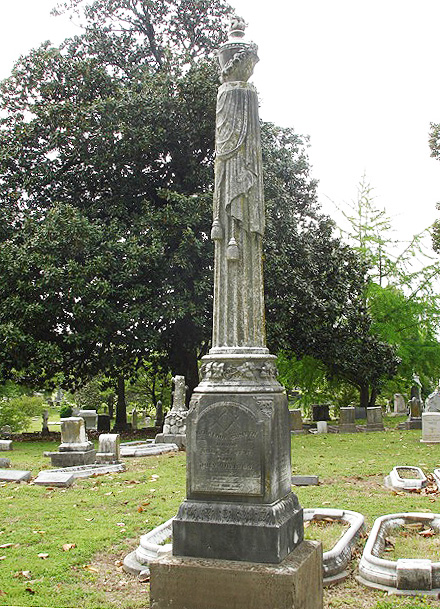 |
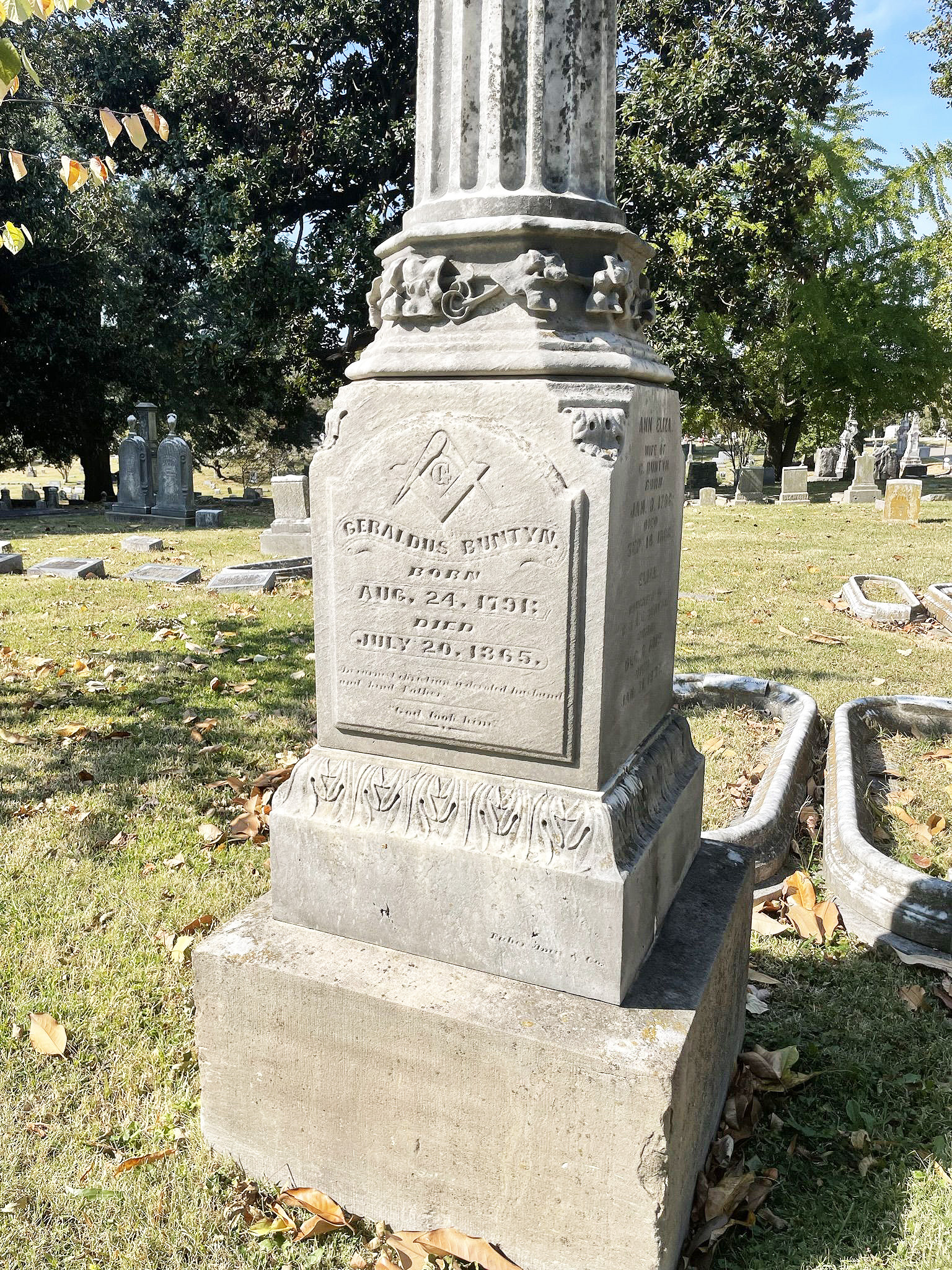 |
|
Buntyn Station |
Buntyn Station |
T. N. College 1912 |
Buntyn Family Markers |
|
|
|
|
After Buntyn's death, his family members sold the
plantation to developers and to the City of Memphis
The 300 acre Audubon campus created out of that purchase
in 1948 now contains a golf course, a city park, and the
Memphis Botanic Gardens. |
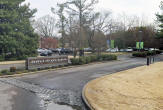 |
| |
Botanic Gardens |
|
|
|
|
Thank you Glinda
Rhodes |
|
|
|
|
|
|
|
|
|
West Tennessee
State Teachers College
1925 |
| |
|
By
1925, the school changed its name to West Tennessee State
Teachers College. It dropped its high school classes and accepted only high school graduates
and began offering four year bachelor's degrees. As enrollment
reached one thousand, the college set the tone for educational
life throughout the mid-south area, producing excellent
teachers and administrators for the rapidly expanding public
school systems.
Several departments were
added to the campus, including physical education, biology,
chemistry, arts, penmanship, and geology. The Brister Library
opened in 1931 - named after president John W. Brister. In 1931 the students created a
new campus newspaper,
"The Tiger
Rag" which will
continue until 1972. And in 1935 the school's agriculture department was
discontinued.
As the new name of the school implies, the emphasis at the college
continues to be
teacher-training. |
 |
| |
1937
Commencement |
|
| |
 |
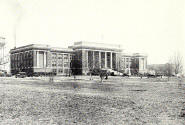 |
 |
 |
|
1928 Aerial View |
1925
Administration |
Mynders-Scates |
1925
4-H Club |
|
| |
 |
 |
 |
 |
 |
|
1925
Campus |
<
Campus Beauties - 1926 > |
1925
Dining Room |
|
| |
 |
 |
 |
 |
 . . |
| 1929
DeSoto |
1925
Cheerleaders |
1926
Rooms |
1940
Aerial View |
1926
Glee Club |
|
| |
|
|
| |
|
First Yearbook ... First
Bulletin ... First Commencement ... |
| |
|
The three covers below, will be of interest to the historian.
The first one is the 1926 DeSoto Yearbook - the first one
under the name West Tennessee State Teachers College. The second is
the first Bulletin issued for the 1925-26 Fall Quarter.
The third one is for the 14th Commencement - the first from
the West Tennessee State Teacher's College.
To see all pages of any of the three publications, click on any cover
below. |
| |
|
 |
 |
 |
|
First Yearbook - 1926 |
First Bulletin - 1925-26 |
First Commencement |
|
| |
| |
|
|
|
|
|
|
|
Memphis State College
1941 |
| |
|
Enrollment
had climbed to about 1,000 students by 1941, and during the
same year the
college changed names again becoming Memphis State College.
In 1946, J. Millard "Jack" Smith became president - the first
alumnus to hold the position. In 1950 graduate studies were
initiated, and in 1954 the school switched from a quarter to a
semester system.
|
|
|
|
|
|
|
 |
 |
 |
 |
 |
 |
|
Basketball 1952 |
Beauty 1947 |
1951 |
Grades 1953 |
Festival 1954 |
Miss
America '48 |
|
| |
 |
 |
 |
 |
 |
|
1941 |
1941 |
1953 Tiger
Rag |
1952 |
1955-Wink
Martindale |
|
| |
 |
 |
 |
 |
 |
|
Training School |
MSC Collector's Plate |
MSC Freshman's Beanie
1951 |
1950 |
1950 |
|
| |
| |
|
The First Yearbook
under
the Memphis State College name - 1941
The DeSoto name was retained for Memphis State College
Click on the cover to see the entire yearbook
= >
|
 |
| |
|
|
|
|
|
| |
| |
|
Memphis State University 1957 |
| |
|
By 1957,
enrollment had doubled to about 2,000 students, when a
proposal to make the school a branch of the University of
Tennessee was shot down. Instead, then-governor Frank Clement
endorsed a bill to grant the college “university” status. It
was renamed once again, becoming Memphis State
University (MSU). The institution admitted its
first black students in 1959. Doctoral programs were offered
beginning in 1966.
President Cecil C. Humphreys oversaw an expansion across the
campus, during the
1960s and ’70s, including the building of the University
Center and a 12-story library. MSU’s entire curriculum was
accredited in 1983 — the first public university in Tennessee to gain that
distinction.
In 1972, the new Student Newspaper "Daily Helmsman" will
debut.
|
| |
 |
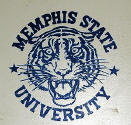 |
 |
 |
|
Memphis State University |
Logo |
Sweat Shirt |
Semester Costs |
|
|
|
 |
 |
 |
 |
|
Marker for "The Eight" |
1959 - The MSU Eight |
1959 - MSU Eight |
"Hair" - 1970 |
|
|
|
 |
 |
 |
 |
 |
|
Aerial View of Campus
|
Jersey 1973 |
Logo 1966 |
Matchbook |
University Status |
|
|
|
|
|
|
|
|
|
|
|
 |
|
|
 |
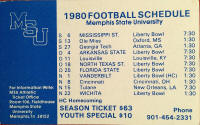 |
|
1966
Football Pass |
|
|
1979 MSU Football |
1980 Football Schedule |
|
|
|
|
The First Yearbook
under
the Memphis State University name - 1958
The DeSoto name was retained for Memphis State
University
Click on the cover to see the entire yearbook
= >
|
 |
| |
|
|
|
|
|
|
|
|
| |
|
University of Memphis
1994 |
| |
|
The last
name change came in 1994: the University of
Memphis. The Ned R. McWherter Library opened the
same year. Two distinguished brands lent their
names to major educational centers at the beginning of the
twenty-first century: the Kemmons Wilson School of Hospitality
and the FedEx Institute of Technology.
Today,
the university now stretches over 1,600 acres and has 237
buildings on eight sites and is one of six universities in the
Tennessee system. It has an annual budget of $439 million and
a local economic impact estimated at $1.43 billion. Total
enrollment for the Fall 2011 semester was 22,725.
The University of Memphis is one of Tennessee's three
comprehensive doctoral-extensive institutions of higher
learning and is the flagship of the Tennessee system. It
awards more than 3,000 degrees annually, has 24 Chairs of
Excellence (more than any other Tennessee University), and
five state-approved Centers of Excellence. |
|
|
|
|
| |
|
|
|
|
| |
|
The First Yearbook
under
the University of Memphis name - 1995
The DeSoto name was retained for University of Memphis
Click on the cover to see the entire yearbook
= >
|
 |
| |
|
|
| |
|
|
|
|
|
|
|
|
|
|
Credits |
|
|
|
The
Historic-Memphis website does not intentionally post copyrighted
photos and material without permission or credit.
On
occasion a "non-credited" photo might possibly be posted because we
were unable to find a name to give credit. Because of the nature of
our non-commercial, non-profit, educational website, we strongly
believe that these photos would be considered "Fair Use. We have
certainly made no monetary gain, although those using this website
for historic or Genealogy research have certainly profited. If by
chance,
we have posted your copyrighted photo, please contact us, and we'll
remove it immediately, or we'll add your credit if that's your
choice. In the past, we have found that many photographers
volunteer to have their works included on these pages and we'll
also do that if you contact us with a photo that fits a particular
page. |
|
|
|
The "Historic-Memphis" website would like to acknowledge and thank the
following for their contributions which helped make this website
possible: Memphis
Public Library, Memphis University Library, Memphis Law Library,
Memphis Commercial Appeal, Memphis Press Scimitar, Shelby County
Register of Deeds, Memphis City Schools, Memphis Business Men's
Club, Memphis Chamber of Commerce, Memphis City Park Commission,
Memphis Film Commision, Carnival Memphis, Memphis Historical
Railroad Page, Memphis Heritage Inc, Beale Street Historic District,
Cobblestone Historic District, Memphis Historic Districts, Vance
Lauderdale Family Archives, Tennessee State Archives, Library of
Congress, Kemmons Wilson Family, Richard S. Brashier, Lee Askew,
George Whitworth, Woody Savage and many individuals whose assistance is
acknowledged on the pages of their contributions. Special
thanks to Memphis Realtor, Joe Spake, for giving us carte blanche
access to his outstanding collection of contemporary Memphis photos.
We do not have high definition copies of the photos on these
pages. If anyone wishes to secure high definition photos,
you'll have to contact the photographer or the collector.
(To avoid any possibility of contributing to SPAM, we do not
maintain a file of email addresses for anyone who contacts us). |
|
|
|
|
|
|
|
|
|
|
|
|
|
|
|
|
|
|
|
|
|